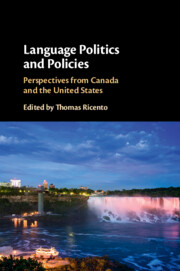Book contents
Introduction
Published online by Cambridge University Press: 18 July 2019
Summary
An important goal of this edited volume is to address the following challenge: What can scholars of language politics and policy contribute to our understanding of things as they are (the "Why?" Question) while also providing concrete suggestions and describing actual policies that have enhanced democratic participation and inclusion (the "What" Answer)? The contributors fully embrace the fundamental reality that virtually all contemporary nation-states have multiple language groups among their citizens, and that acceptance and legitimation of linguistic and cultural diversity is beneficial for societal well-being, and not just beneficial for minority/minoritized language communities. In exploring and explaining language politics and policies in diverse contexts in Canada and the United States, using a variety of data sources and disciplinary perspectives, the authors describe the challenges and set-backs, along with the many positive steps taken in recent years to advance the interests and aspirations of speakers of marginalized/minoritized languages. The authors remain hopeful that positive change is possible while acknowledging that ideologies about language and the role of language in national development and identity remain potent forces that are often difficult to challenge, let alone dislodge, when they become embedded in the daily lives and common sense views of citizens.
Keywords
- Type
- Chapter
- Information
- Language Politics and PoliciesPerspectives from Canada and the United States, pp. 1 - 24Publisher: Cambridge University PressPrint publication year: 2019
References
- 2
- Cited by

